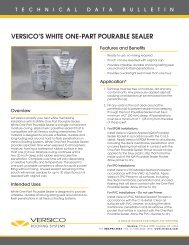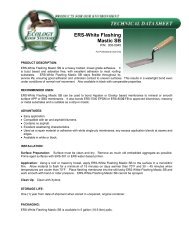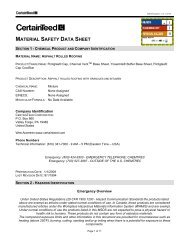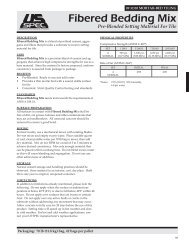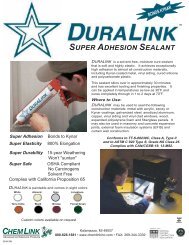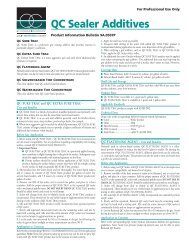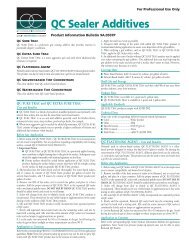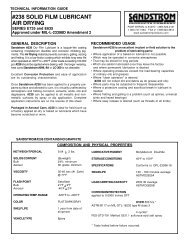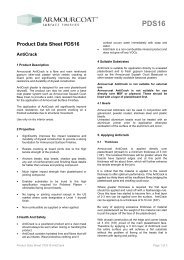Simpson Anchors - Anchoring and Fastening Systems - BuildSite.com
Simpson Anchors - Anchoring and Fastening Systems - BuildSite.com
Simpson Anchors - Anchoring and Fastening Systems - BuildSite.com
Create successful ePaper yourself
Turn your PDF publications into a flip-book with our unique Google optimized e-Paper software.
Crack Injection<br />
104<br />
EPOXY-TIE ®<br />
Troubleshooting<br />
Epoxy is fl owing into the crack, but not showing up at the next port.<br />
This can indicate that either the crack exp<strong>and</strong>s <strong>and</strong>/or branches off<br />
under the surface of the concrete. Continue to inject <strong>and</strong> fi ll these voids.<br />
In situations where the crack penetrates <strong>com</strong>pletely through the<br />
concrete element <strong>and</strong> the backside of the concrete element cannot be<br />
sealed (e.g basement walls, or footings with backfi ll) longer injection<br />
time may not force the epoxy to the next port. This most likely indicates<br />
that epoxy is running out of the unsealed back side of the crack. In this<br />
case the application may not be suitable for epoxy injection repair<br />
without excavation <strong>and</strong> sealing of the back side of the crack.<br />
Back pressure is preventing epoxy from fl owing.<br />
This can indicate several situations:<br />
• The crack is not continuous <strong>and</strong> the portion being injected is full (see<br />
above instructions about injection after the port has reached refusal).<br />
• The port is not aligned over the crack properly.<br />
• The crack is blocked by debris.<br />
• If the mixing nozzle has been allowed to sit for a few minutes full<br />
of epoxy, the material may have hardened in the nozzle. Attach the<br />
E-Z-Click fi tting to a port at another uninjected location on the<br />
crack <strong>and</strong> attempt to inject. If the epoxy still won't fl ow, chances<br />
are the epoxy has hardened in the nozzle.<br />
Gravity-Feed Procedure<br />
Some horizontal applications where <strong>com</strong>plete penetration is not a<br />
requirement can be repaired using the gravity feed method.<br />
1. Follow cartridge preparation instructions on the cartridge label. Verify<br />
that the material fl owing from the Opti-Mix ® mixing nozzle is a uniform<br />
gray color for ETI-LV <strong>and</strong> ETI-GV. For Crack-Pac ® injection epoxy verify<br />
that the mixed material in the cartridge is a clear amber color.<br />
Width<br />
of<br />
Crack<br />
(in.)<br />
¹⁄₆₄<br />
¹⁄₃₂<br />
¹⁄₁₆<br />
¹⁄₈<br />
³⁄₁₆<br />
Concrete<br />
Thickness<br />
(in.)<br />
Approximate<br />
Coverage<br />
per 22 oz.<br />
Cartridge<br />
(linear ft.)<br />
Injection Guide<br />
ESTIMATING GUIDE FOR EPOXY CRACK INJECTION<br />
Approximate<br />
Coverage<br />
per 9 oz.<br />
Crack-Pac<br />
Cartridge<br />
(linear ft.)<br />
Width<br />
of<br />
Crack<br />
(in.)<br />
Concrete<br />
Thickness<br />
(in.)<br />
Approximate<br />
Coverage<br />
per 22 oz.<br />
Cartridge<br />
(linear ft.)<br />
4 47.6 18.4<br />
4 3.0<br />
6<br />
8<br />
31.8<br />
23.8<br />
12.3<br />
9.2<br />
¹⁄₄<br />
6<br />
8<br />
2.0<br />
1.5<br />
10 19.1 7.4 10 1.2<br />
4 23.8 9.2<br />
4 2.4<br />
6<br />
8<br />
15.9<br />
11.9<br />
6.1<br />
4.6<br />
⁵⁄₁₆<br />
6<br />
8<br />
1.6<br />
1.2<br />
10 9.5 3.7 10 1.0<br />
4 11.9 4.6<br />
4 2.0<br />
6<br />
8<br />
7.9<br />
6.0<br />
3.1<br />
2.3<br />
³⁄₈<br />
6<br />
8<br />
1.3<br />
1.0<br />
10 4.8 1.9 10 0.8<br />
4 6.0 2.3<br />
4 1.7<br />
6<br />
8<br />
4.0<br />
3.0<br />
1.5<br />
1.2<br />
⁷⁄₁₆<br />
6<br />
8<br />
1.1<br />
0.9<br />
10 2.4 0.9 10 0.7<br />
4 4.0 1.5<br />
4 1.5<br />
6<br />
8<br />
2.6<br />
2.0<br />
1.0<br />
0.8<br />
¹⁄₂<br />
6<br />
8<br />
1.0<br />
0.7<br />
10 1.6 0.6 10 0.6<br />
Coverage listed is approximate <strong>and</strong> will vary depending on waste <strong>and</strong> condition of concrete.<br />
Epoxy is leaking from the pasted-over crack or around injection ports.<br />
Stop injecting. If using a fast cure paste-over material (ETR or CIP),<br />
wipe off the leaking injection epoxy with a cotton cloth <strong>and</strong> re-apply the<br />
paste over material. Wait approximately 10–15 minutes to allow the<br />
epoxy to begin to harden. If the leak is large (e.g. the port broke off of<br />
the concrete surface) it is a good idea to wait approximately 30 minutes,<br />
or longer as necessary, to allow the paste over to cure more <strong>com</strong>pletely.<br />
Check to see that the epoxy is hard before reinjecting or the paste-over<br />
or ports may leak. Another option for small leaks is to clean off the<br />
injection epoxy <strong>and</strong> use paraffi n or crayon to seal the holes.<br />
More epoxy is being used than estimated.<br />
This may indicate that the crack either exp<strong>and</strong>s or branches off below<br />
the surface. Continue to inject <strong>and</strong> fi ll these voids. This may also<br />
indicate that epoxy is running out of the back side of the crack. If the<br />
crack penetrates <strong>com</strong>pletely through the concrete element <strong>and</strong> cannot<br />
be sealed, the application may not be suitable for injection repair.<br />
Less epoxy is being used than estimated.<br />
This may indicate that the crack is shallower than originally thought,<br />
or the epoxy is not penetrating the crack suffi ciently before moving to<br />
the next port. Reinject some ports with a lower viscosity epoxy to see if<br />
the crack will take more epoxy. Another option is to heat the epoxy to a<br />
temperature of 80–100°F which will reduce its viscosity <strong>and</strong> allow<br />
it to penetrate into small cracks easier. The epoxy should be heated<br />
uniformly, do not overheat cartridge.<br />
2. Starting at one end of the crack, slowly dispense epoxy into the crack,<br />
moving along the crack as it fi lls. It will probably be necessary to do<br />
multiple passes in order to fi ll the crack. It is possible that the epoxy<br />
will take some time to run into the crack, <strong>and</strong> the crack may appear<br />
empty several hours after the initial application. Reapply the epoxy until<br />
the crack is fi lled. In situations where the crack <strong>com</strong>pletely penetrates<br />
the member (e.g. concrete slab) the material may continue to run<br />
through the crack into the subgrade. In these cases epoxy repair may<br />
not provide an effective repair.<br />
Tip: For narrow cracks, run a bead of caulk along each side of the<br />
crack approximately ¹⁄₈" from the edge of the crack. This will form a<br />
reservoir into which epoxy can be dispensed. Alternatively, use a<br />
grinder to route the crack opening into a “V” shape. Take care to clean<br />
the crack with <strong>com</strong>pressed air afterwards as grinding can impact dust<br />
<strong>and</strong> debris into the crack <strong>and</strong> prevent proper fl ow of the epoxy.<br />
<strong>Simpson</strong> Strong-Tie does not re<strong>com</strong>mend<br />
repair of cracks larger than ¹⁄₄" wide without<br />
consulting a qualifi ed engineer.<br />
C-SAS-2009 © 2009 SIMPSON STRONG-TIE COMPANY INC.



